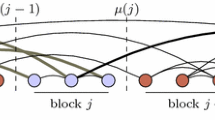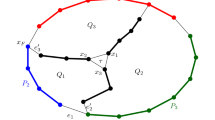Abstract
The Min Cut Linear Arrangement problem is to find a linear arrangement for a given graph such that the cutwidth is minimized. This problem has important applications in VLSI layout systems. It is known that this problem is NP-complete when the input is a general graph with maximum vertex degree at most 3. In this paper, we will first present a linear time algorithm to recognize the small cutwidth trees. The approach we used in this algorithm can then be easily extended to recognize the general graphs with cutwidth 3 in O(n) time.
This work was supported by the National Science Council, Taiwan, R.O.C. Grant NSC 80-0404-E194-03
Preview
Unable to display preview. Download preview PDF.
Similar content being viewed by others
References
Alok Aggarwal, Richard J. Anderson, and Ming Yanf Kao, “Parallel Depth-First search in general directed graphs,” SIAM J. Comput., Vol. 19, No. 2, April 1990, pp. 397–409.
C. Berge, Graphs and Hypergraphs, North-Holland, Amsterdam 1973.
F. Buckley and F. Harary, Distance in Graphs, Addison-Wesley, Reading, 1990.
Fan R. K. Chung, “On the Cutwidth and the Topological Bandwidth of a Tree,” SIAM J. Alg. Disc. Meth., Vol. 6, No. 2, April 1985, pp. 268–277.
M. J. Chung, F. Makedon, I. H. Sudborough and J. Tarner, ”Polynomial algorithm for the min-cut linear arrangement problem on degree restricted trees,” SIAM J. Comput., Vol. 14, No. 1, 1985, pp. 158–177.
A. E. Dunlop and B. W. Kernighan, ”A Procedure for Placement of Standard-Cell VLSI Circuits,” IEEE Trans. on Computer-Aided Design of Integrated Circuits and Systems, Vol. CAD-4, No. 1, Jan. 1985, pp. 92–98.
M. R. Garey, D. S. Johnson, Computers and Intractability: A Guide to the Theory of NP-Completeness, Freeman, San Franciso 1979.
E. Gurari, and I. H. Sudborough, ”Improved dynamic programming algorithms for bandwidth minimization and min-cut linear arrangement problem,” J. Algorithms, Vol. 5, 1984, pp. 531–546.
M. Y. Kao, ”All graphs have cycle separators and planar directed depth-first search is in DNC,” in Proc. 3rd Aegean Workship on Computing, Corfu, Greece, J. H. Reif, ed.; Lecture Notes in Computer Science 319, Springer-Verlay, Berlin, New York, 1988, pp. 53–63.
Thomas Lengauer, ”Upper and Lower Bounds on the Complexity of the Min-Cut Linear Arrangement Problem on Trees,” SIAM J. Alg. Disc. Meth., Vol. 3, No. 1, March 1982, pp. 99–113.
A. D. Lopez, and H. F. S. Law, ”A Dense Gate Matrix Layout Method for MOS VLSI,” IEEE Trans. on Electronic Devices, ED-27, 8, 1980, pp. 1671–1675.
F. S. Makedon, C. H. Papadimitriou and I. H. Sudborough, ”Topological Bandwidth,” SIAM J. Alg. Disc. Meth., Vol. 6, No. 3, July 1985, pp. 418–444.
Sanda L. Mitchell, ”Linear Algorithms to Recognize Oulplanar and Maximal Outerplanar Graphs,” Information Processing Letters, Vol. 9, No. 5, December 1979, pp. 229–232.
T. H. Ohtsuki, H. Mori, E. S. Kuh, T. Kashiwabara and T. Fujiswa, ”One Dimensional Logic Gate Assignment and Interval Graphs,” IEEE Trans. Circuits and Systems, Vol. 26, 1979, pp. 675–684.
A. L. Rosenberg, ”The Diogenes Approach to Testable Fault-Tolerant Arrays of Processors,” IEEE Trans. on Computers, Vol. C-32, No. 10, Oct. 1983, pp. 902–910.
R. E. Tarjan, ”An Efficient Parallel Biconnectivity Algorithm,” SIAM J. Comput., Vol. 14, No. 4, November 1985, pp. 862–874.
M. Yannakakis, ”A Polynomial Algorithm for the Min Cut Linear Arrangement of Trees,” J. ACM., Vol. 32, No. 4, 1985, pp. 950–988.
Author information
Authors and Affiliations
Editor information
Rights and permissions
Copyright information
© 1992 Springer-Verlag Berlin Heidelberg
About this paper
Cite this paper
Chen, MH., Lee, SL. (1992). Linear time algorithms for k-cutwidth problem. In: Ibaraki, T., Inagaki, Y., Iwama, K., Nishizeki, T., Yamashita, M. (eds) Algorithms and Computation. ISAAC 1992. Lecture Notes in Computer Science, vol 650. Springer, Berlin, Heidelberg. https://doi.org/10.1007/3-540-56279-6_54
Download citation
DOI: https://doi.org/10.1007/3-540-56279-6_54
Published:
Publisher Name: Springer, Berlin, Heidelberg
Print ISBN: 978-3-540-56279-5
Online ISBN: 978-3-540-47501-9
eBook Packages: Springer Book Archive





